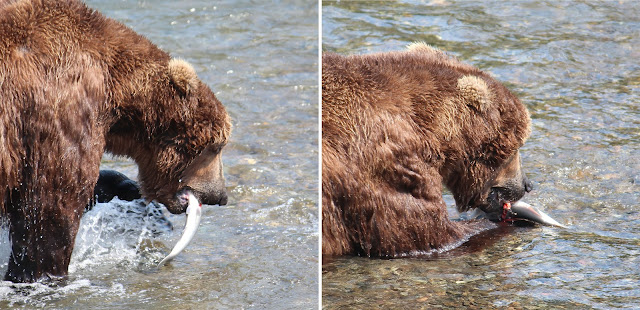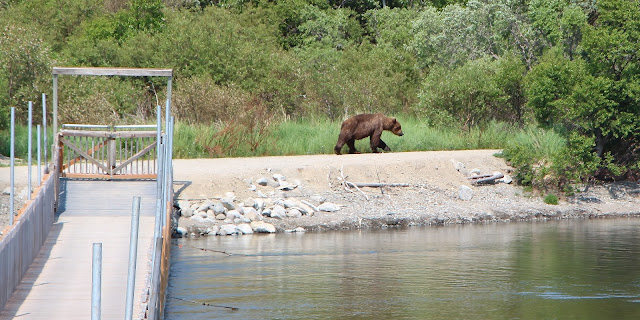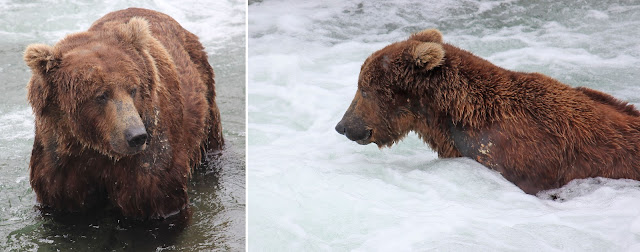 |
| Fishing Bear |
Today, we went back to Brooks Falls at Brooks Camp at Katmai National Park via floatplane.
 |
| A Bear Patrolling where the floatplanes park on the beach |
As I mentioned, we had tried earlier, but, because the salmon hadn't yet arrived, there were no Bears at the falls. We saw only one Bear swimming across Naknek Lake on his way to the falls. But Glen (Alsworth, our host and pilot) had heard that the salmon had arrived ...
There are viewing platforms by the falls and the riffles after the falls. During busy times, the number of people and amount of time they can stay is limited, but this early in the season, we had no time limits.
The idea is to let bears be bears without human interference.
Brooks also has a live video cam. Check it out here.
 |
| Salmon jumping the falls |
... and Bears were there ...
 |
| Although we saw a lot, we didn't see many together |
And, were they ever. We saw 15 (ish -- we lost count). At one time, we could see five at the falls and riffles.
 |
| This one is taking a shower |
There was a lot of coming and going, including a Bear that came down the opposite bank ...
 |
| Let's see what's happening |
... and then, after seeing the rough looking Bears at the falls ...
... turned around and went back ...
 |
| I ain't messin' with you |
Many photos of Brooks Falls show Bears sitting on the upper ledge of the falls. When we were there, we didn't see any Bears doing that. All were at the base.
 |
| Fishing below the falls |
In case you don't know, Brooks Falls is famous as the gathering place for Bears to feed on salmon. It is located at Brooks Camp in Katmai National Park.
 |
| A successful catch |
Because Bears -- even when intent on fishing and/or stuffed with food -- are dangerous and because the National Park is there, primarily to protect the environment and the wildlife, all visitors must obey strict hiking and viewing rules.
 |
| A rare moment of eye contact |
When you arrive, you have to attend a Bear safety class at the Visitor Center before you can go to any of the viewing platforms.
 |
| The raised and gated boardwalk to the platforms |
 |
| Chillin' by the chilly falls |
There are Bears everywhere, so there are strict rules about food (you can eat only in a small enclosure surrounded by electrified wires).
If Bears are near the trail, it is closed until they move on.
 |
| You can see the gate on the walkway as this Bear cruises by |
About the Falls
Located on the Brooks River a mile and a half from Brooks Lake and an equal distance from Naknek Lake, Brooks Falls are where salmon leap over the 6 foot drop to get to their Brooks Lake spawning grounds.
 |
| The most famous Bear gathering spot |
Brown Bears (also called Grizzly Bears, although that term is used more often for inland, not coastal bears) usually congregate at the falls in July through early September, and many well-known photos of Bears have been taken there.
 |
| He is just ignoring photographers |
July witnesses the greatest concentrations of Bears of any month at the falls; up to 43 bears have been seen at one time at Brooks Falls in that July.
 |
| Taking off after a salmon |
In September, a smaller number of bears (usually up yo only about 18 at one time) can be seen at the falls to feast on the later salmon runs. Of course, we were early -- visiting in June.
 |
| Fishing |
In 1921, Kidawik Creek was renamed Brooks River, and Toms Lake renamed Brooks Lake. A controversial "stream improvement" was implemented in 1920 by the United States Bureau of Fisheries, when they cut a 10 foot gap on the south bank of the river, which was widened to 15 feet the next year.
 |
| Did these changes help or hurt the Bears? The salmon? |
Between 1948 and 1950, the bureau, by then reorganized into the United States Department of the Interior′s Fish and Wildlife Service (later the United States Fish and Wildlife Service), built a fish ladder in the gap as part of its "landscape improvements."
 |
| I didn't see evidence of these structures (but i wasn't looking) |
In 1974, the NPS closed the ladder and in 1986, placed sandbags to block salmon access. The Alaska Department of Fish and Game opposed a 1987 NPS proposal to dismantle the ladder, and the structure remains, though not used.
Similarly, a seasonal weir for counting salmon was constructed in 1940 by the bureau, across the outlet of Brooks Lake at Brooks River. This was replaced by a permanent one in 1952.
 |
| This young 'un tried, but never caught anything while we were there |
The bureau, renamed the National Marine Fisheries Service, transferred ownership of the weir to the NPS in 1978.
 |
| Bears with fisherman downstream |
Before the 1950s, when Brooks Camp was opened, there were fewer Bears at the falls than there are today, and no more than 6-7 could be observed at one time. That is because it was still legal to hunt Bears there. People who visited the falls were generally there to fish rather than watch and photograph Bears. Once hunting was banned and viewing controlled, Bear numbers quadrupled.
The site's archaeological human remnants date back some 9,000 years, some of the oldest human remains in North America.
Since the site is not far from the Bering Land Bridge, it is quite possible that some of the first humans from Russia made villages here. Native Americans still continue to harvest food caches and live their own ways of life at a site not far from the falls known as the Old Savonoski Site.











No comments:
Post a Comment